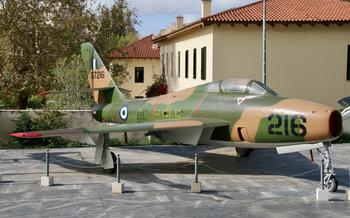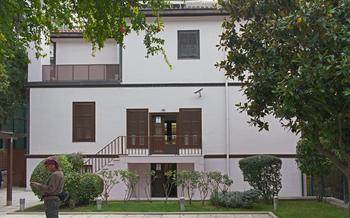
Thracian Art and Tradition Museum
- Location and Accessibility
- Museum Hours and Admission
- Exploring the Museum's Exhibits
- The Thracian Room: A Journey into History
- Traditional Crafts and Textiles
- The Art of Thracian Jewelry
- Thracian Pottery and Ceramics
- Ancient Thracian Rituals and Beliefs
- The Thracians and the Greeks: A Complex Relationship
- Educational Programs and Workshops: Engaging with the Past
- Museum Shop and Souvenirs
- Insider Tip: Explore the Neighborhood
Location and Accessibility
The Thracian Art and Tradition Museum is conveniently situated in the heart of Komotini, at 28th October Street, making it easily accessible for visitors. To reach the museum, you can take advantage of the city's public transportation system, with buses stopping nearby. If you prefer to drive, there are ample parking spaces available in the vicinity of the museum. Additionally, the museum is designed to be accessible for visitors with disabilities, ensuring a comfortable and inclusive experience for all.
Museum Hours and Admission
The Thracian Art and Tradition Museum in Komotini welcomes visitors year-round, offering a captivating journey into the rich cultural heritage of the region. The museum's operating hours are designed to accommodate a variety of schedules, ensuring that visitors have ample opportunity to explore its exhibits.
The museum is open Tuesday through Saturday, from 10 am to 2 pm and 5 pm to 9 pm. On Sundays, it remains open from 10 am to 2 pm, allowing visitors to delve into the museum's treasures during the weekend. During the summer months, the museum extends its hours to provide even more time for exploration, staying open until 10 pm on select evenings.
Admission to the museum is affordable, allowing visitors of all backgrounds to immerse themselves in the wonders of Thracian art and tradition. A regular ticket costs a modest fee, while reduced rates are available for students, seniors, and groups. The museum also offers free admission to visitors with disabilities, ensuring that everyone has equal access to its cultural riches.
Guided tours are available upon request, providing visitors with an in-depth understanding of the museum's exhibits and the fascinating stories they tell. These tours are conducted by knowledgeable and passionate guides who bring the Thracian civilization to life, shedding light on its history, traditions, and enduring legacy. Advance booking is recommended to secure a spot on a guided tour, especially during peak tourist season.
Exploring the Museum's Exhibits
The Thracian Art and Tradition Museum is a treasure trove of artifacts and exhibits that showcase the rich cultural heritage of the Thracian civilization. The museum is divided into several sections, each dedicated to a different aspect of Thracian life and culture.
One of the highlights of the collection is the display of traditional costumes. Visitors can admire the intricate embroidery and colorful designs of these garments, which were worn by Thracians for both everyday and special occasions. Another highlight is the pottery and ceramic section, which features a variety of vessels, from simple cooking pots to elaborately decorated vases.
The museum also boasts an impressive collection of jewelry, including gold and silver pieces adorned with intricate designs. These pieces provide a glimpse into the skill and artistry of Thracian craftsmen. Interactive displays and multimedia presentations throughout the museum enhance the visitor experience, providing additional information and context for the exhibits.
The Thracian Room: A Journey into History
Step into the Thracian Room, a captivating space dedicated to showcasing the rich history and culture of the ancient Thracians. This immersive exhibit transports visitors back in time, offering a glimpse into the lives, traditions, and achievements of this enigmatic civilization.
Through meticulously preserved artifacts and engaging dioramas, the Thracian Room recreates scenes from Thracian history and culture. Discover the intricate details of their elaborate tombs, marvel at the artistry of their gold and silver treasures, and witness the grandeur of their religious ceremonies.
Immerse yourself in the fascinating world of the Thracians as you explore their unique way of life. Learn about their social structure, their economic activities, and their intricate belief systems. Uncover the secrets of their remarkable craftsmanship, from intricate jewelry to finely crafted pottery and textiles.
The Thracian Room is not just a collection of artifacts; it is a testament to the enduring legacy of a civilization that played a pivotal role in shaping the history of the region. As you wander through this captivating exhibit, you will gain a deeper appreciation for the Thracians and their enduring contributions to the cultural tapestry of Greece.
Traditional Crafts and Textiles
The Thracian Art and Tradition Museum houses a significant collection of traditional crafts and textiles, showcasing the rich artistic heritage of the region. Visitors can admire intricate weavings, colorful embroideries, and finely crafted metalwork, each piece a testament to the skill and artistry of the Thracian people.
Displays of traditional weaving techniques, using looms and natural fibers, provide a glimpse into the intricate process of creating these beautiful textiles. Visitors can witness the transformation of simple threads into vibrant fabrics, adorned with geometric patterns and motifs inspired by nature.
Embroidery, another important craft in Thracian culture, is represented by a collection of exquisitely embroidered garments, tablecloths, and wall hangings. The intricate designs and vibrant colors, often depicting scenes from daily life or traditional symbols, showcase the patience and creativity of the artisans.
Metalworking, a skill passed down through generations, is showcased through a variety of objects, from finely crafted jewelry to intricate household items. Visitors can admire the delicate filigree work, the hammered and chased surfaces, and the symbolic motifs that adorn these metal pieces.
To enhance the visitor experience, the museum organizes demonstrations of traditional crafts, allowing visitors to witness the artisans at work and learn about the techniques and skills involved. Workshops are also offered, providing participants with the opportunity to try their hand at these traditional arts and create their own unique pieces.
These traditional crafts not only represent the artistic talents of the Thracian people but also serve as a vital means of preserving local heritage and identity. By supporting these crafts and the artisans who practice them, the museum plays a crucial role in ensuring the continuity of these traditions for future generations.
The Art of Thracian Jewelry
The Thracian Art and Tradition Museum houses an exquisite collection of Thracian jewelry, adorned with intricate designs and symbolism. Gold and silver pieces of necklaces, bracelets, rings, and earrings are carefully displayed, showcasing the masterful craftsmanship and artistry of the Thracian people. The jewelry is not merely decorative, but holds deep cultural significance. Each piece carries unique symbols, often representing deities, nature, or personal identities. Visitors can admire the intricate patterns and motifs, which depict animals, plants, and geometric shapes. The collection provides a glimpse into the personal adornment and social status of the Thracians, highlighting the importance of jewelry in their cultural identity.
Thracian Pottery and Ceramics
The Thracian Art and Tradition Museum houses an impressive collection of pottery and ceramic artifacts, offering visitors a glimpse into the everyday life and artistic traditions of the ancient Thracians. These objects range from functional items such as pots, jugs, and bowls to decorative pieces like vases, figurines, and tiles.
The variety of styles and techniques employed by Thracian potters is evident in the collection. Some pieces are characterized by their simple, utilitarian forms and earthy tones, while others showcase intricate designs and vibrant colors. The museum also features examples of specialized ceramic techniques, such as black-glazed pottery and red-figure painting.
The significance of pottery in Thracian society extended beyond its practical uses. Ceramics played an important role in religious rituals and ceremonies, serving as offerings to the gods and as containers for sacred liquids. The rich symbolism and iconography found on many of the vessels provide valuable insights into Thracian beliefs and mythology.
By examining the pottery and ceramic artifacts at the Thracian Art and Tradition Museum, visitors can gain a deeper understanding of the daily lives, artistic achievements, and spiritual practices of this ancient civilization.
Ancient Thracian Rituals and Beliefs
The Thracian Art and Tradition Museum offers a glimpse into the spiritual beliefs and practices of the ancient Thracians. Exhibits showcase artifacts related to ancestor worship, fertility rites, and healing practices, providing insights into their religious customs. Visitors can explore the significance of these rituals in Thracian society, gaining a deeper understanding of their cultural identity. Among the highlights are intricate masks used in religious ceremonies, votive offerings to deities, and tools associated with healing practices. These exhibits offer a fascinating journey into the sacred world of the Thracians, revealing their deep connection to the divine and the natural world.
The Thracians and the Greeks: A Complex Relationship
The relationship between the Thracians and the ancient Greeks was complex and multifaceted, marked by both cooperation and conflict. The two civilizations shared a long and intertwined history, with periods of peaceful coexistence and fierce rivalry.
The Thracians were known for their skilled cavalry and fierce warriors, while the Greeks were renowned for their naval power and cultural achievements. This disparity in military strength led to numerous conflicts between the two peoples, with the Greeks often seeking to expand their influence into Thrace.
Despite their conflicts, the Thracians and Greeks also engaged in cultural exchange and trade. The Greeks adopted some Thracian customs and religious practices, while the Thracians were influenced by Greek art and philosophy. This cultural exchange contributed to the rich and diverse heritage of the region.
One of the most significant historical events that shaped the relationship between the Thracians and the Greeks was the Battle of Thermopylae in 480 BC. In this battle, a small force of Spartans and their allies, including a contingent of Thracians, fought against the invading Persian army. Although the Greeks were ultimately defeated, their heroic stand inspired the rest of Greece to unite and resist the Persian invasion.
The Thracians and the Greeks continued to interact and influence each other throughout the centuries. The legacy of their complex relationship can still be seen in the cultural heritage of the region, where elements of both civilizations have blended to create a unique and vibrant tapestry.
Educational Programs and Workshops: Engaging with the Past
The Thracian Art and Tradition Museum offers a range of educational programs and workshops that cater to students, teachers, and the general public. These programs delve into the rich history, art, and traditions of the Thracian civilization, providing an immersive experience that brings the past to life.
The museum's educational offerings include guided tours tailored to different age groups and interests. School groups can book guided tours that align with their curriculum, exploring specific aspects of Thracian culture and history. These tours are designed to be interactive and engaging, fostering a deeper understanding of the region's heritage.
The museum also organizes workshops and seminars for adults and enthusiasts who wish to delve deeper into Thracian art and traditions. These workshops cover various topics, such as traditional crafts, pottery techniques, and Thracian mythology. Participants have the opportunity to learn from experts in the field, engage in hands-on activities, and create their own works of art inspired by the Thracian legacy.
By offering educational programs and workshops, the Thracian Art and Tradition Museum plays a vital role in promoting cultural awareness, preserving the region's heritage, and inspiring future generations to appreciate and celebrate the rich legacy of the Thracians.
Museum Shop and Souvenirs
The Thracian Art and Tradition Museum houses a charming museum shop where visitors can delve deeper into the cultural heritage of the region through a selection of souvenirs and gifts. The shop offers an array of books that delve into the history, art, and traditions of Thrace, allowing visitors to continue their exploration beyond the museum walls. Additionally, postcards featuring stunning images of Thracian artifacts and landscapes are available, providing a tangible reminder of the museum's treasures.
For those seeking unique and authentic mementos, the museum shop showcases a variety of locally-made crafts and replicas of Thracian artifacts. These exquisite pieces, crafted with care and precision, serve as a testament to the enduring legacy of Thracian artistry. By purchasing these souvenirs, visitors not only support the museum's efforts to preserve and promote Thracian heritage but also contribute to the livelihoods of local artisans.
Insider Tip: Explore the Neighborhood
After immersing yourself in the rich cultural heritage of the Thracian Art and Tradition Museum, take some time to explore the surrounding neighborhood and discover the vibrant city of Komotini. Just a short walk away, you'll find the Komotini Archaeological Museum, which houses a fascinating collection of artifacts from the region's prehistoric and classical periods.
Venture a bit further, and you'll reach the heart of the Old Town, where you can wander through narrow cobblestone streets lined with traditional houses and charming shops. Admire the intricate architecture, visit local markets, and indulge in the delicious cuisine at one of the many tavernas and restaurants. Komotini is renowned for its culinary scene, so be sure to sample some of the local specialties, such as the delicious grilled meats, fresh seafood, and traditional pastries.
As you explore the neighborhood, you'll discover a city that seamlessly blends its rich history with a modern and cosmopolitan vibe. Komotini is a place where the past and present intertwine, offering a unique and unforgettable travel experience.



